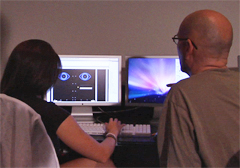Getting Intuit
It’s a feeling that both artists and researchers are familiar with: a problem seems unsolvable when suddenly, in a flash, a creative solution becomes clear. This moment of insight might get credited to instinct or your gut, but what if it’s more than a hunch? What if it’s part of how the brain solves problems, as trustworthy as conscious thought?
That’s what Lee Boot, associate director of UMBC’s Imaging Research Center (IRC), asked himself when he was invited by the National Academy of Sciences (NAS) to prepare an exhibit for October’s USA Science and Engineering Festival on the National Mall. Now, nearly a year later, IRC is preparing to unveil an exhibit that leads visitors to reach the “eureka” of intuitive insight and teaches them what is happening in their brain at that moment.
“It was important for us to invite an artist to explore this perspective. Lee’s research was extensive and his group’s ability and willingness to bring together a variety of perspectives is one of the reasons we felt that working with him would be a fertile exploration,” said J.D. Talasek, director of cultural programs of the NAS. In many ways, the NAS and the IRC were a perfect fit: the NAS creates exhibitions and programs that explore the intersection of art, science and culture, while the IRC investigates how science and art can influence each other to lead to greater understanding.
To Boot, intuition is at the core of this connection, because it can lead to discoveries in all disciplines. “The fact that scientists have discovered a part of your brain that people who have an intuitive insight have used gives validity to an entire way of thinking,” he said. “It’s one of the things that human brains do that pocket calculators don’t.”
Boot worked with IRC artists and researchers including Abbey Salvo ’10, computer animation; Eric Smallwood ’03, digital arts,’10 M.F.A. imaging and digital arts, and IRC technical director; Gianfranco Mirizzi, M.F.A. imaging and digital arts student; David Gurzick ’09 Ph.D., information systems; and Shane Lynch ’09, computer science, to conceptualize an exhibit that would allow visitors to both learn about intuition and experience their own moment of insight. They eventually settled on a large black booth with four peepholes, through which visitors will watch short films that comprise different parts of a scene. Visitors are invited to intuit what the larger scene that connects the four short films might be and share their ideas, which will be displayed on a screen. On the side of the booth is an interactive visualization where visitors can see what happened in their brain as they watched the film and reached the insight.
“We want them to experience their own brain at an intuitive moment,” said Boot.
In order to create the visualization, IRC researchers read scientific papers on the “neural basis of insight,” and consulted with scientists about the accuracy of the IRC’s representations. They eventually developed an illustration that reflected both the current knowledge and the artists’ impressions. “We want to be consistent with the science, but there are a lot of different windows through which we can look at the human experience,” said Boot.
In addition to helping visitors understand their own brains, the booth will help scientists understand the visitors’ brains. It was designed so that the videos, visualizations and even the graphics on the side could be changed, allowing researchers to use it to collect data about how to help people achieve intuitive insight. This fits another of the IRC’s goals: to use art to contribute to scientific discoveries.
“When you think about what artists can bring to research, I think it is comfort with intuition, comfort with improvisation and comfort and skills with playing,” said Dan Bailey, director of the IRC.
Before the booth heads down to the National Mall for the Festival it will be in the Commons on October fourth (12-5 p.m.) and fifth (9 a.m.-5 p.m.). Boot hopes to get feedback that can be implemented before the festival on October 23-24, which is expected to attract thousands of attendees.
(9/24/10)

